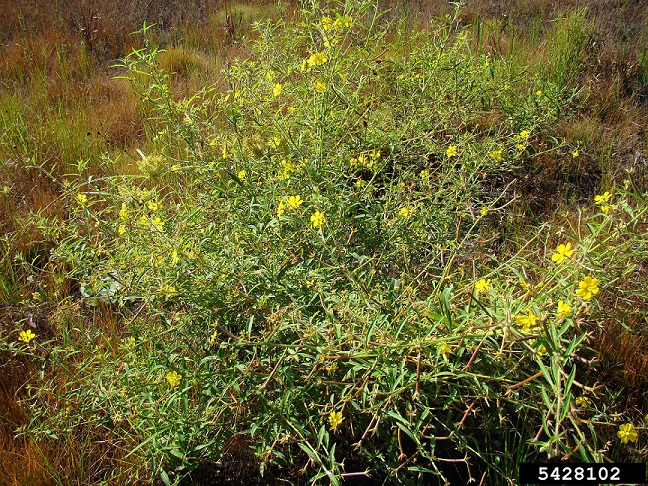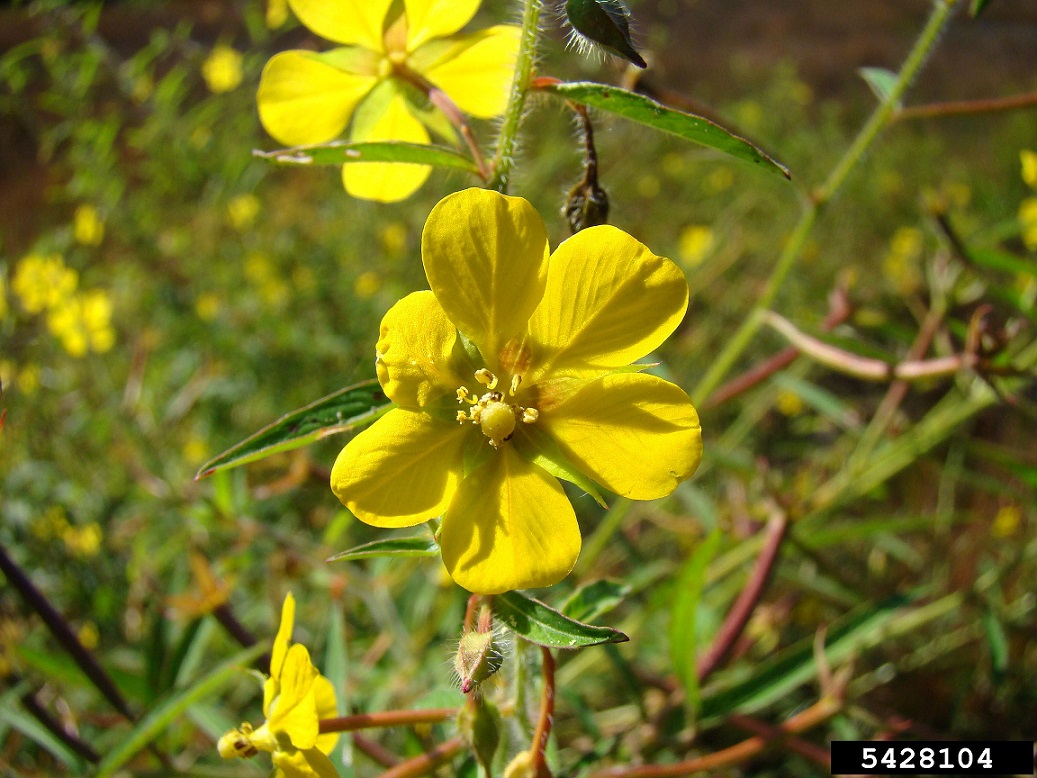Ludwigia leptocarpa
| Ludwigia leptocarpa | |
|---|---|

| |
| Photo by Rebekah D. Wallace, University of Georgia, Bugwood.org | |
| Scientific classification | |
| Kingdom: | Plantae |
| Division: | Magnoliophyta - Flowering plants |
| Class: | Magnoliopsida – Dicotyledons |
| Order: | Myrtales |
| Family: | Onagraceae |
| Genus: | Ludwigia |
| Species: | L. leptocarpa |
| Binomial name | |
| Ludwigia leptocarpa (Nutt.) H. Hara | |

| |
| Natural range of Ludwigia leptocarpa from USDA NRCS Plants Database. | |
Common name: Anglestem primrose-willow
Contents
Taxonomic notes
The specific epithet L. leptocarpa means slender-fruited[1].
Description
“Repent or erect, usually branched, short-lived perennials, or rarely annual. Floral parts in 4-7’s; hypanthium not prolonged beyond ovary. Capsules longitudinally or poricidally multiseriate, rarely uniseriate. Most of the erect species produce basal offshoots, which have ovate to obovate leaves, in the late summer and fall. Bracteoles occur in pairs on the pedicel or stipe or on the base of the hypanthium.” – Radford et al 1964
"Stems erect, branched, pubescent, to 1 m tall. Leaves alternate, elliptic, pubescent, to 12 cm long and 3 cm wide; sessile or subsessile. Sepals 5-7, lanceolate, pubescent, 4.5-7 mm long, 2-3 mm wide; petals 5-7, 5.5-7.5 mm long, 4-8 mm wide. Capsules cylindric, 2-5 cm long, 2-3.5 mm in diam.; bracteoles subulate, ca. 0.5 mm long; pedicels absent or to 2 cm long; seeds uniseriate, free inside brownish endocarp." - Radford et al 1964
Distribution
It is distributed throughout North America and tropical Africa (Mabou et al. 2015). Individuals occurring at the northern edge of the range in North America behave as an annual species (Dolan and Sharitz 1984).
Ecology
Habitat
Habitats of L. leptocarpa in the Coastal Plain in Florida include lake margins, around cypress ponds, wet ditches bordering swamps, drainage ditches bordering pine flatwoods, wet sloughs, inter-dune ponds, and growing on decaying vegetation. It has been observed growing in disturbed areas such as roadways and Kudzu dominated seepage areas. Soil types include sandy loam, loamy sand, sandy soil, peaty sand, and sandy peat. Associated species include L. decurrens and L. sphaerocarpa (FSU Herbarium).
In rice paddies and other cultivated swamp lands it can become a serious weed (Oziegbe and Faluyi 2011).
Phenology
Flowering occurs May through November and fruiting July through November (FSU Herbarium). Reproduction can be either vegetative or sexual (Oziegbe and Faluyi 2011). Depending on the location, it can be either an annual or perennial species (Dolan and Sharitz 1984).
Seed dispersal
The seeds have a specialized endocarp that remains attached and enables the seed to float. The seed capsule length is highly correlated with seed number (Dolan and Sharitz 1984).
Seed bank and germination
Dolan (1984) found that seed size does influence germination, with smaller seeds germinating quicker due to the thinner seed coats for the embryos to penetrate. They also observed that populations in South Carolina have little or no seed banks.
Biomass and seed production increases under higher environmental temperatures (Christy and Sharitz 1980).
Fire ecology
Pollination
The following Hymenoptera families and species were observed visiting flowers of Ludwigia leptocarpa at Archbold Biological Station (Deyrup 2015):
Apidae: Apis mellifera, Bombus impatiens
Vespidae: Polistes fuscatus
Use by animals
Diseases and parasites
Conservation and Management
Cultivation and restoration
Photo Gallery
Flowers of Ludwigia leptocarpa Photo by Rebekah D. Wallace, University of Georgia, Bugwood.org
References and notes
Deyrup, M.A. and N.D. 2015. Database of observations of Hymenoptera visitations to flowers of plants on Archbold Biological Station, Florida, USA.
Florida State University Robert K. Godfrey Herbarium database. URL: http://herbarium.bio.fsu.edu. Last accessed: October 2015. Collectors: Loran C. Anderson, K. Craddock Burks, George R. Cooley, A.H. Curtiss, Richard J. Eaton, William B. Fox, J.P. Gillespie, Robert K. Godfrey, Gary R. Knight, R. Komarek, R. Kral, Karen MacClendon, Travis MacClendon, Richard S. Mitchell, R.A. Norris, James D. Ray Jr., Annie Schmidt. States and Counties: Florida: Bay, Calhoun, Duval, Franklin, Gadsden, Hernando, Hillsborough, Jackson, Jefferson, Leon, Liberty, Madison, Okaloosa, Putnam, Santa Rosa, Taylor, Wakulla, Walton. Compiled by Tall Timbers Research Station and Land Conservancy.
Radford, Albert E., Harry E. Ahles, and C. Ritchie Bell. Manual of the Vascular Flora of the Carolinas. 1964, 1968. The University of North Carolina Press. 744-5. Print.
